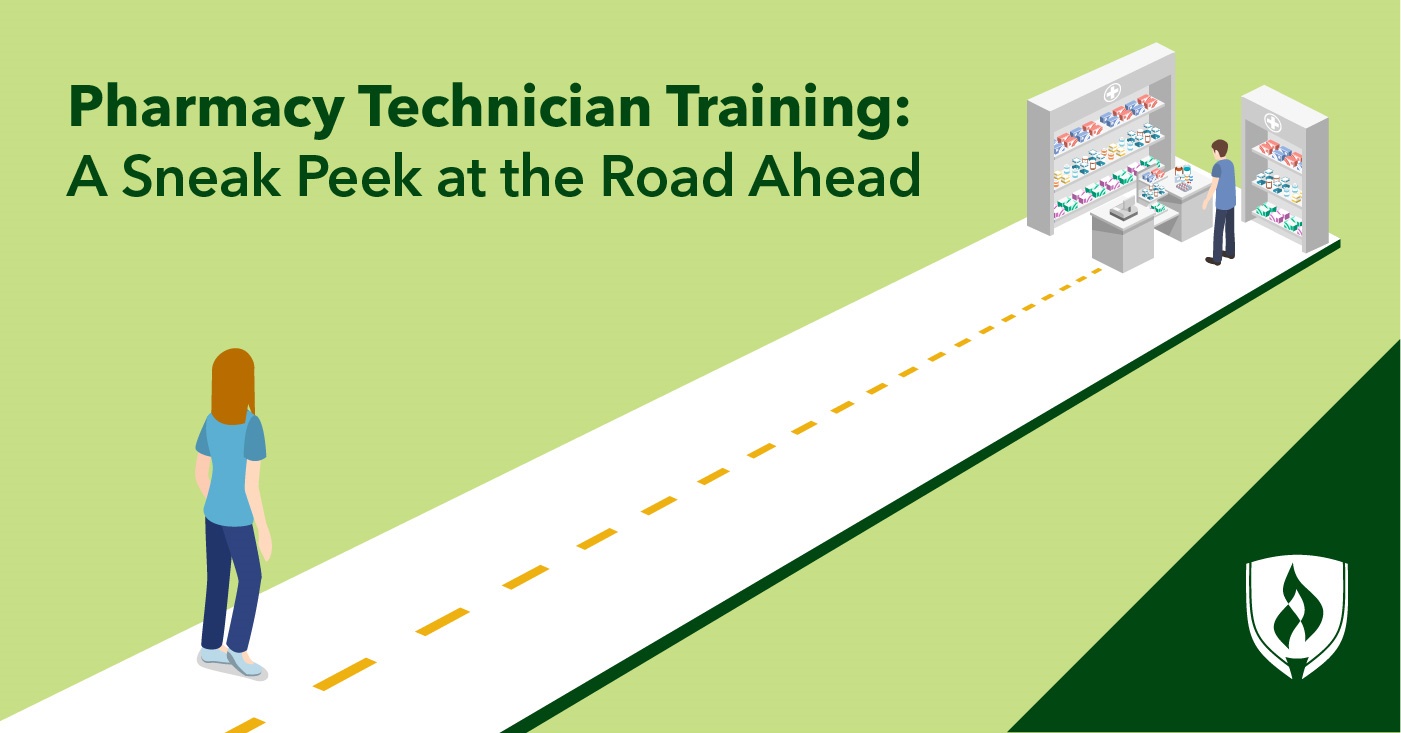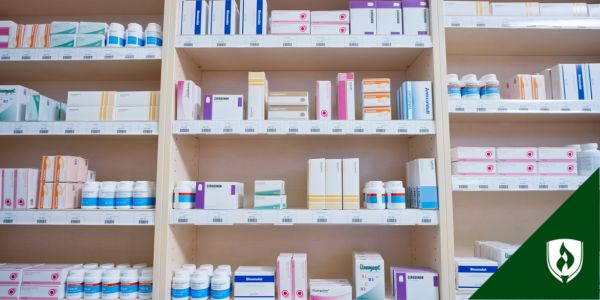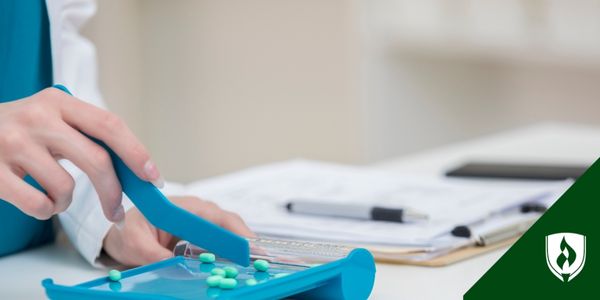
If you’ve made a trip to your local pharmacy to pick up a prescription, there’s a good chance you weren’t thinking too much about the people working behind the counter—you just wanted to get your medicine and get on with life feeling a little better. While these healthcare professionals might not have been top-of-mind in the moment, the role has caught your eye now that you’re considering your career options.
The people behind the counter, more often than not, are pharmacy technicians. They play a critical role in the daily operations of a pharmacy as they assist customers with insurance issues, handle medications and prepare orders for pickup. Sound like it could be a fit for you? You’ll be happy to know that there’s a relatively quick path to working as a pharmacy technician—the Certificate program at Rasmussen University can be completed in as few as 9 months!1
So what can you expect from pharmacy technician training? In this article we’ll take a closer look at what you’ll see on your way to working in a pharmacy and break it down step by step.
Pharmacy technician training: A step-by-step guide
1. Choosing a pharmacy tech program
Though it is possible to land a pharmacy technician job with just a high school diploma, many employers prefer candidates to have some post-secondary training/education and to be certified. To earn this certification, you must take the Pharmacy Technician Certification Board (PTCB) exam. In order to do that, candidates must complete a PTCB-recognized education program, like the Rasmussen University Pharmacy Technician Certificate program, or have equivalent work experience.
In addition to ensuring your selected program will qualify you to get certified, you’ll want to make sure your pharmacy tech program fits your life. One factor that can weigh heavily on your decision is the overall flexibility of the program. If you’re currently working, fitting a traditional on-campus education into your schedule may be challenging. The fully-online Pharmacy Technician program at Rasmussen University can help you make it work with courses that include interactive sessions and virtual labs that can be completed from home.
2. Complete your pharmacy tech courses
Once you choose your program and enroll, the next step is no surprise—you’ll need to pass your courses! Along the way you can pick up the key skills and competencies needed to work effectively in a fast-paced healthcare environment. So what can you expect to find in your Pharmacy Technician coursework? Let’s take a peek at some of the courses offered at Rasmussen University:
- Foundations of Pharmacy Practice: In this course, you’ll get an introduction to the history of pharmacy and the role of a pharmacy technician. You’ll learn the basics of pharmacy laws and safety guidelines, compounding equipment, billing procedures, types of medication and routes of administration. You’ll also become familiar with pharmacy terminology and abbreviations.
- Sterile and Non-Sterile Compounding: This course will prepare you to use pharmacy math skills to calculate doses for sterile and non-sterile products. You’ll learn proper aseptic technique, compounding non-sterile products, and how to handle chemotherapy medications and other sensitive biological agents.
- Pharmacy Technician Capstone: This capstone will give you the opportunity to review all you’ve learned and prepare for the Pharmacy Technician Certification Board Examination.
3. Build practical experience
When you’re starting at square one, one of the best ways to boost your resume and build experience in the field is through a practicum opportunity arranged through your college program. During this time you may shadow established pharmacy technicians and get a real feel for what the day-to-day is like in a pharmacy environment. The Rasmussen University Pharmacy Technician program provides students practicum opportunities in retail and virtual pharmacy environments. Both are great chances to further your knowledge and practical skills so you’ll be able to hit the ground running after graduation.
This practicum experience is also an excellent opportunity to learn more about the different pharmacy environments you could potentially be working in—from drug store pharmacies to hospitals or compounding pharmacies.
4. Get certified
Once you graduate from your program, it’s time to begin studying and preparing to take the Pharmacy Technician Certification Board exam. The two-hour, 90-question multiple-choice exam covers four primary focus areas:
- Medications
- Federal requirements
- Patient safety and quality assurance
- Order entry and processing
You can prepare for the exam by taking practice exams and utilizing the Pharmacy Technician Certification Board mobile app that allows you to practice on the go. Once you pass, you will be a certified pharmacy technician and ready to apply for pharmacy tech positions with confidence.
5. Apply to pharmacy tech positions
Once you’re certified, it’s time to focus on your job search. Aside from certification, employers will also be looking for the right mix of skills and characteristics. The best pharmacy technicians have strong communication skills. They need to collaborate with other pharmacy team members and spend a considerable amount of time assisting customers and working with insurance providers. We all know navigating health insurance issues can be a frustrating process, so strong people skills and the ability to communicate clearly are very valuable. Bring your charm and try to have examples of excellent customer service in mind when it is time to interview.
In addition to having strong people skills, you need to be detail-oriented as well. Ensuring safety is a top priority for pharmacists, and pharmacy techs play a key role in flagging potentially dangerous medication issues and ensuring prescriptions are filled accurately and precisely. This may mean double-checking dosages and the customer’s health record to see if they need to talk with pharmacists about how to take a new medication or about any issues they are having.
Another highly-valued skill is your ability to stay organized and how you prioritize tasks that may be competing for your attention. Can you easily switch streams from one type of task to another without missing a beat?
You’ll want to demonstrate all of these skills as best you can and tailor your resume to fit the job. At Rasmussen University, you can get a head start on this by meeting with a career services advisor to help you with your resume.
Ready to start your pharmacy technician training?
Now that you know a little more about what to expect with pharmacy technician training and education, are you feeling ready to take that first step toward a new career in healthcare? At Rasmussen University, you’ll have the support and flexibility needed at every step of the process. Start the next chapter in your professional life and learn more by visiting the Pharmacy Technician Certificate program page.
Related Articles:
Rasmussen University will reimburse the application fee for each qualified student’s first attempt of one of the following industry certification exams: Pharmacy Technician Certification Examination® (PTCE®) or Exam for the Certification of Pharmacy Technicians (ExCPT). Should you need to take an exam more than once to receive a passing grade score, you will be responsible for all subsequent exam application fees.
1Time to completion is dependent on the number of transfer credits accepted and the number of courses completed each term.




